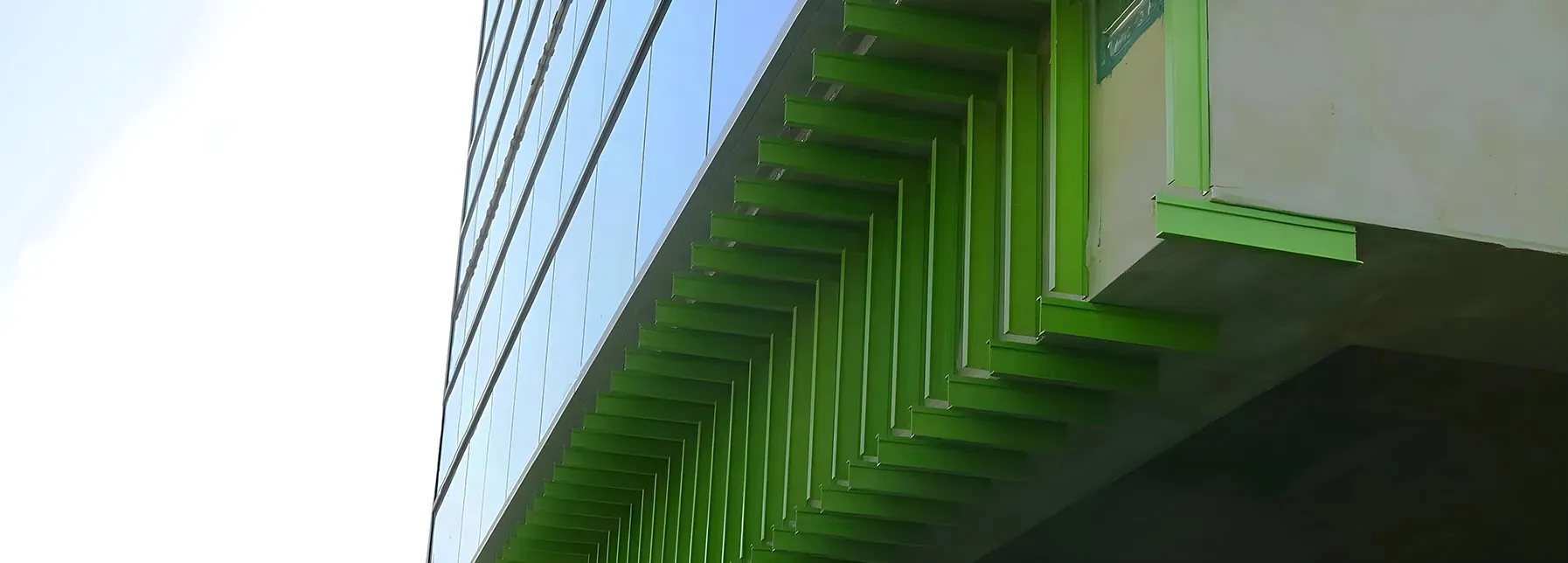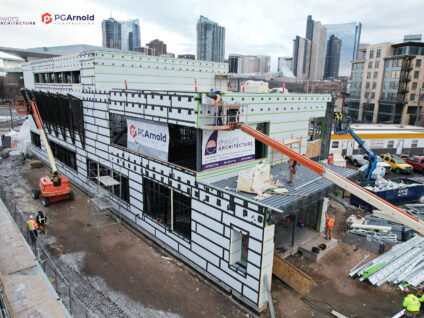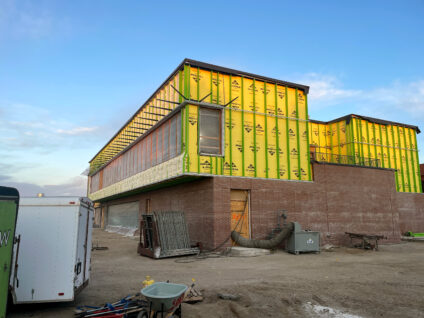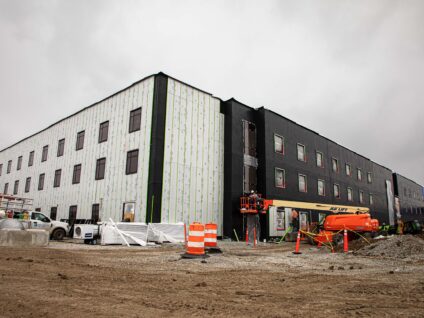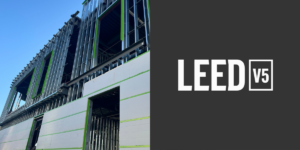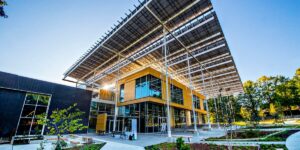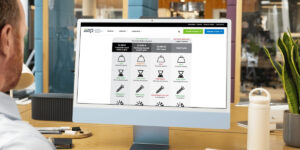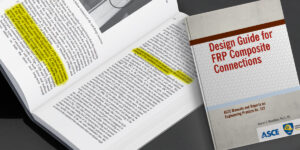Environmental Sustainability and Healthy Buildings
Sustainability has become a large factor in most aspects of modern life, including the commercial building industry. It is important to understand the long-term effects and impact that products and materials have on our environment. Intricately related to public health and safety, improving sustainability goals is more prevalent now than ever before.
Green building standards and ratings, including Leadership in Energy and Environmental Design (LEED) certification, Living Building Challenge (LBC), Red List Free certification, Declare Label, and Environmental Product Declaration (EPD), promote human and environmental health. This is accomplished through sustainably healthy buildings and reducing the overall environmental impact of building materials. Regulations and guidelines continue to evolve with innovative advancements in science and technology, along with our understanding of the positive and negative effects materials, chemicals, and other elements have on human and environmental health.
Your building project can earn credits toward green building certifications by meeting the guidelines listed below.
Do your building materials meet the recycled content, environmental standards, and guidelines listed below?
Use the following checklist to determine if the building materials you are using meet environmentally healthy building standards and regulations.
Environmentally Healthy Building Checklist:
 Certified Halogen/Bromine-Free Materials
Certified Halogen/Bromine-Free Materials
Halogen/bromine-based fire-retardants are considered organohalogen compounds. Organohalogen compounds consist of at least one halogen (fluorine (F), chlorine (CI), bromine (Br), or iodine (I)) bonded with carbon. These compounds have the potential to be toxic, persistent, bio-accumulative, and/or leach into the environment throughout their lifespan. This risk is ongoing during all stages of a product’s life cycle, from building to landfill.
Furthermore, products containing halogen/bromine-based fire retardants release highly toxic dioxins and furans into the environment when burning. Many building owners, architects, and fire inspectors, along with local, national, and international regulations, have sharply restricted or eliminated the use of these harmful flame retardants.
 The Living Building Challenge (LBC) Red List Free Certification
The Living Building Challenge (LBC) Red List Free Certification
The Living Building Challenge (LBC) Red List represents materials and chemicals often found in the building industry that are known and proven to cause harm to overall human and environmental health. The LBC Red List was created by The International Living Future Institute (ILFI), a non-profit working toward restoring our environment and ecosystem to healthy standards. The Red List is regularly reviewed and updated to stay relevant to technology and the building material industry.
To qualify as Red List Free, manufacturers must disclose 100 percent of their product’s ingredients and ensure they do not contain any Red List chemicals at or above 100 ppm or 0.01 percent. By practicing complete transparency of what materials, chemicals, and elements are in a product, a manufacturer can earn Red List Free certification.
The ILFI’s goal is to phase out and eliminate the use of these harmful materials and chemicals. This will create a more sustainable and healthier ecosystem for future generations. To achieve sustainability, it is imperative that manufacturers do not use harmful materials, chemicals, and elements. Have you checked the elements of your building materials to ensure they are not causing harm to human and environmental health?
 Declare Label
Declare Label
Declare is a product labeling program that assists manufacturers and specifiers with identifying materials in the marketplace by providing three key points. These key points include (1) where a product comes from, (2) what a product is made of, and (3) where a product goes at the end of its life. Relying on the LBC Red List as its primary basis for material evaluation, Declare Label supports the catalyst for change within the material industry. It does this by pushing for healthy buildings.
A Declare Label discloses the following information about a product or material:
- Final assembly locations
- Embodied carbons
- End-of-life options (salvageable or re-usable)
- Ingredients by component
- LBC temporary exceptions
- Declare identifier (valid for 12 months)
- Original issue date
 Environmental Product Declaration (EPD) Type III (Product Specific)
Environmental Product Declaration (EPD) Type III (Product Specific)
An Environmental Product Declaration (EPD) offers complete transparency of the environmental impact throughout the entire life cycle of a product. Additionally, organizations carry out testing through a life cycle assessment (LCA) to identify the overall environmental performance of a product.
EPDs showcase a manufacturer’s dedication to sustainability through healthy building materials. Furthermore, organizations thoroughly test and verify an EPD before registering it to the International EPD System database. The EPD database helps builders and developers identify products to use to create a healthy building.
 LEED Certification Recycled Content Requirements
LEED Certification Recycled Content Requirements
Recycled content refers to materials within a product that companies repurpose and divert from the landfill. Utilizing products consisting of recycled contents contributes to green building and environmental sustainability. Are your building materials recyclable?
Best Practice Solutions: GreenGirt CMH Continuous Insulation and SMARTci Building Enclosure Systems
GreenGirt CMH continuous insulation and SMARTci building enclosure system offer best practice solutions for your healthy building project. Advanced Architectural Products’ systems meet or exceed environmental building standards and regulations set forth by the Living Building Challenge (LBC) Red List free certification, Declare Label, LEED certification, and Environmental Product Declaration (EPD). Utilizing 25% post-consumer recycled content, the GreenGirt CMH Z-girt sub-framing, used in both GreenGirt CMH and SMARTci systems, allows for reuse and repurposing. Superior to steel structurally and thermally, GreenGirt CMH sub-framing meets and exceeds the criteria set forth by these standards and guidelines, contributing to the overall health of buildings, the environment, and the entire population.
Learn more on how GreenGirt CMH continuous insulation and SMARTci building enclosure systems meet and exceed environmental standards and guidelines.
Download the Environmentally Healthy Building Checklist.
The Living Building Challenge (LBC) Red List Download Now
Download information about the Declare Label System and products.
© 2022 Advanced Architectural Products

